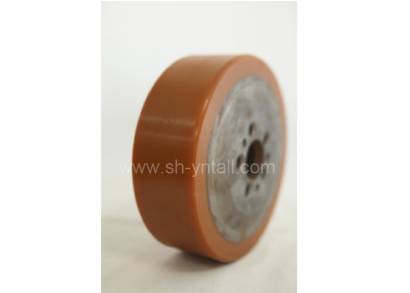Polyurethane Casters Are Super Wear-Resistant!
The elastic body of PU castor wheels has good performances such as wear resistance, chemical resistance, high strength, high elasticity, low-pressure resistance, strong shock absorption, tear resistance, radiation resistance, high load-bearing, and shock absorption buffer. Polyurethane casters also have a wide range of hardness, ranging from Shore A10-100. In addition, the polyurethane casters have excellent sound absorption characteristics. The wheels do not generate noise during the movement and can achieve a silent effect. These characteristics of PU wheels are very suitable as caster materials.
Industrial PU wheels installation height: refers to the vertical distance from the ground to the installation location of the equipment, the installation height of the casters refers to the vertical distance between the caster bottom plate and the wheel side. Bracket steering center distance: refers to the horizontal distance from the vertical line of the center rivet to the center of the wheel core. Turning radius: refers to the horizontal distance from the vertical line of the central rivet to the outer edge of the tire. The proper spacing allows the casters to turn 360 degrees. The reasonable rotation radius directly affects the service life of casters. Driving load: The load-bearing capacity of the caster when it is moving is also called a dynamic load. The dynamic load of the caster varies according to the factory test method and the material of the wheel. The key is whether the structure and quality of the bracket can resist impact Shock.
Industrial Pu Wheels
Shock load: the instant load-bearing capacity of the caster when the equipment is impacted or shaken by the load. Static load: The weight that the caster can withstand at rest. The static load should generally be 5-6 times the exercise load (dynamic load), and the static load should be at least 2 times the impact load. Steering: Hard, narrow wheels are easier to steer than soft, wide wheels. The turning radius is an important parameter for the rotation of the wheels. If the turning radius is too short, it will increase the steering difficulty, and if it is too large, it will cause the wheels to sway and shorten life. Driving flexibility: The factors that affect the driving flexibility of casters are the structure of the bracket and the choice of bracket steel, the size of the wheel, the type of wheel, and the bearing. The larger the wheel, the better the driving flexibility. The hard and narrow on a stable ground The wheels are less labor-intensive than the soft wheels with flat edges, but the soft wheels on the uneven ground save effort, but the soft wheels on uneven ground can better protect the equipment and absorb shock!
PU Castor wheels for forklifts are widely used in trolleys, mobile scaffolds, workshop trucks, etc.
Simple inventions are often important, and casters have this characteristic. At the same time, the degree of development of a city is often positively related to how much the casters are used. The rate of caster usage is very high.
The structure of the caster is made of a single wheel mounted on a bracket, which is used to be installed under the device so that it can move freely. Casters are mainly divided into two categories:
A fixed caster
The fixed bracket is equipped with a single wheel and can only move in a straight line.
B movable caster
The 360-degree steering bracket is equipped with single wheels and can be driven in any direction at will.
There are many types of casters, which vary in size, model, tire surface, etc. Choosing the right wheel depends on the following conditions:
Use the site environment.
B Product load
C The working environment contains chemicals, blood, grease, oil, salt, and other substances.
D Various special climates, such as humidity, high temperature, or severe cold E requirements for impact resistance, collision, and quiet driving.

评论
发表评论